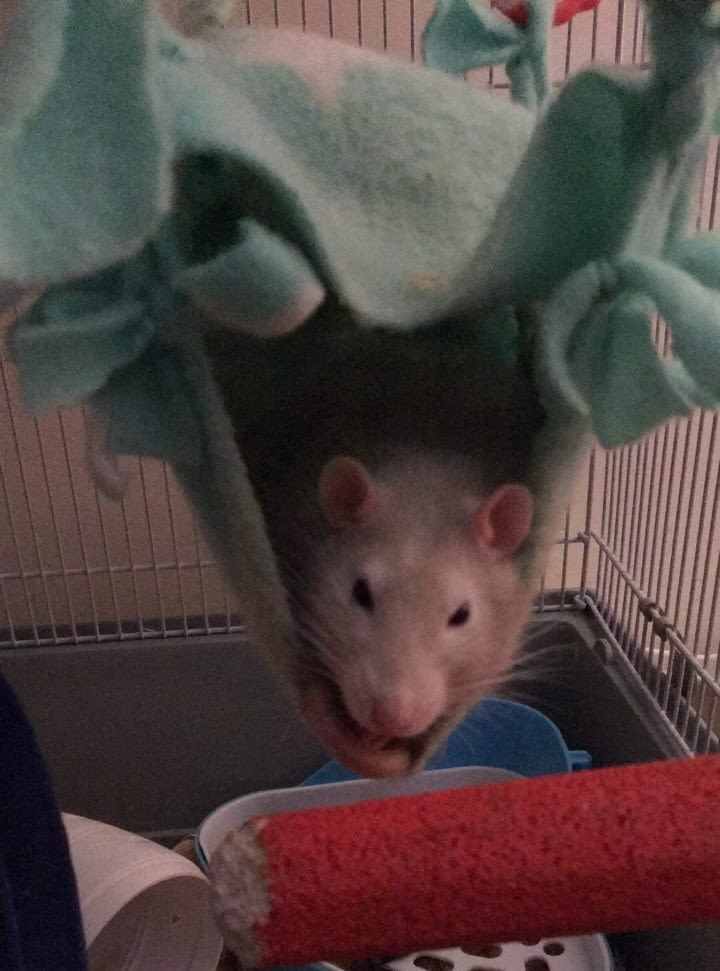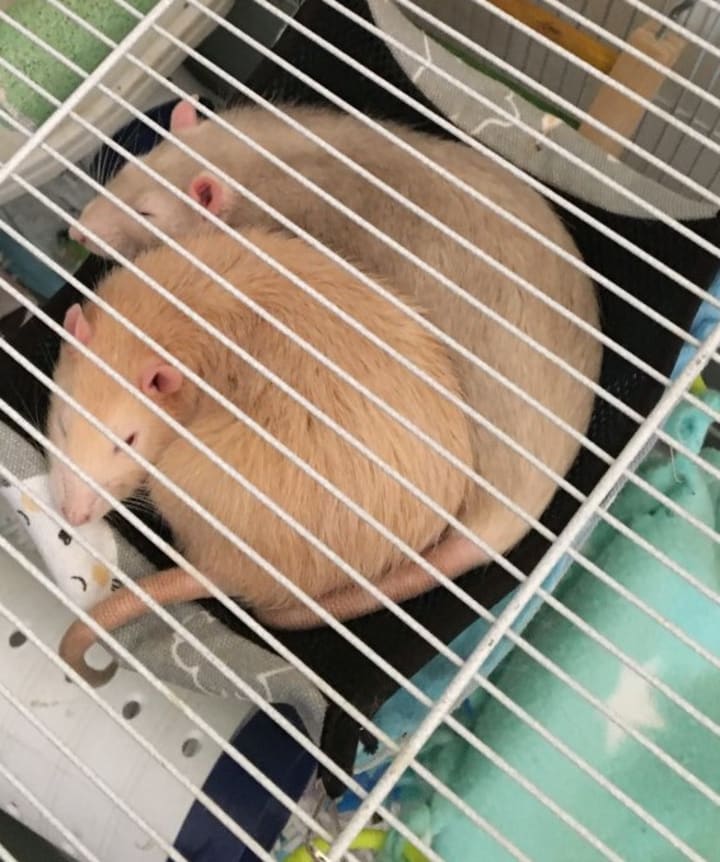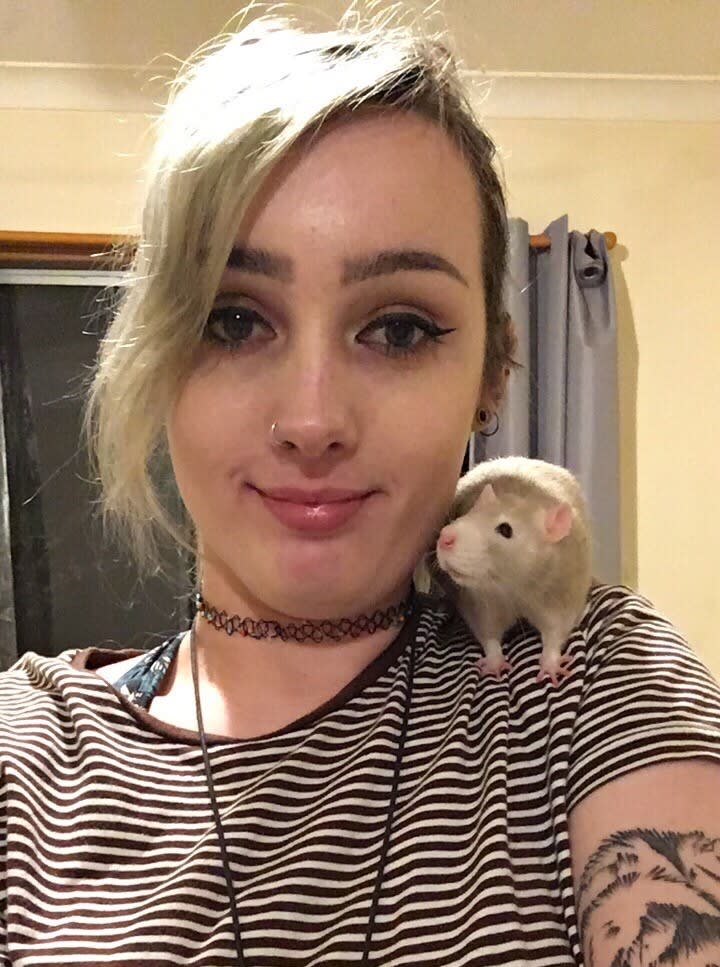Owning Pet Rats
Two-years of learning experiences

I decided to become a rat mum on a whim. I realized later that this was not a mistake per se, but I probably would have benefitted from doing my research before making the two-year commitment my boys would ensure. Just because they are a little pet, rats are not by any means low maintenance. I found this out the hard way.
Choosing The Cage
First, it was the cage. We bought our boys when they were babies. Vodka could fit easily in the palm of my hand and Baileys would sleep comfortably in a plastic mouse house. This didn’t last. The first cage we had them living in was for mice. They would rattle up and down the ramps all night because that is all they could do for fun. The lack of sleep would lead us to become delirious. It was clear they needed room to grow. He looked at me incredulously and said, “they’re not goldfish.” While this was true, I explained that neither were they mice, and they were quickly outgrowing their cage. Baileys soon struggled to fit in his favourite little house.
During my search for a suitable rat cage, I found that rats need a lot of space. It is better to go big or go home. So, I was going to deliver on that. We eventually chose the cage with the least amount of metal bars because I had read that wire shelving and balconies could cause bumblefoot in rats. Bumblefoot causes the rat’s foot to swell and become inflamed when a rat has been exposed to an abrasive surface.
In the end, we settled on a standard flat-based cage. It had a plastic bottom and wire caging on top. Because it was horizontal, it didn’t fit our living space well and it usually took both of us to move it. I eventually figured out that I could split the cage into two pieces and move it that way. I would take the wire cage top off first and then move the plastic base to get cleaned, but this was fiddly and time-consuming. If I were to choose the cage again, it would be vertical so I could put it in the corner of the room and ideally, it would have wheels that would be easier to move and clean.

Remodelling The Cage
A plastic platform sat in the corner of the cage and it would always be the first thing to get dirty. It was notorious for being a bitch to put back into the cage after it was clean. I learnt later that most rat owners take the platform out because rats tend to pee on plastic surfaces. I replaced the plastic platform with a rattan weave tie rack and that seemed to work for a while. However, my ratties did what rats do best and chewed the tie rack apart, making it collapse in on itself. I bought another one and made sure this one was fabric. That worked because they hardly chewed it and it didn’t get nearly as dirty as the rattan weave holder or the platform. Most importantly I could wash it easily; even on a day that was mostly overcast, it was dry after only a couple of hours.
Their cage came with a plastic litter tray and it was sizable, but I wanted one that had a cover as it is more hygienic. The cover had holes in it so the droppings are separated from where the rats would sit on the tray.
After I discovered that rats make a habit of peeing on plastic surfaces, I made a point of limiting plastic items in their cage. Apart from the litter tray, the only plastic items were a tunnel and an igloo-shaped house on the floor of the cage, and a Sputnik up in the top left. After some research, I found that Sputniks are beneficial during the summer months. It is a cooler option when hammocks are just too hot, especially here in Australia when it gets up to an unbearable 40 degrees. The thing they peed on the most now was the igloo, but I didn’t want to remove it because they did enjoy it.

Bedding
Figuring out bedding or something to line the cage proved to be the most difficult. If I am being honest, I only recently found bedding that ticked all the boxes for my ratties’ needs. The material needed to be liquid- and odor-absorbent. When we first got our boys, we lined their cage with sawdust. We learned early on that sawdust can cause respiratory issues for rats, which is something rats are predisposed to get and the sawdust tends to exacerbate this issue. It also did nothing for the ammonia smell that accompanied rats’ urine. And while it was unpleasant for us, it is an even bigger issue for rats, because the ammonia in their urine can also cause more frequent respiratory infections.
We tried shredded newspaper next. I think they enjoyed making nests with it. However, the shredded newspaper was also not absorbent. We would have to find something else.
Next, I tried puppy pee pads. They were obviously absorbent and they also made good nests, but they did not take away the ammonia smell. At this point, I was getting desperate. I even spent eighty bucks on a fleece cage liner. Unfortunately, fleece is just as bad as all the other alternatives I had used thus far, in that it also failed to absorb the ammonia.
Finally, I found exactly what I had been looking for: Back-2-Nature: Small Animal Bedding (not sponsored). The product is in the form of pellets made from recycled paper, which means it is biodegradable – unlike the pee pads. The pellets are both liquid- and odor-adsorbent. It’s easy to tell when pellets are wet, as they become darker, whereas when we used the sawdust, it was difficult to tell the difference between the wet and dry bedding. But what ultimately sold me on it was the fact that this bedding is practically dust-free. No more breathing problems!

Recurring Illnesses In Rats
When I told my mum that I wanted to get rats when I was living at home, she told me that they can develop health problems out of nowhere. I didn’t know how true this was until I woke up one day and saw that Baileys had red stuff around his nose and eyes. I would learn later that this was called porphyrin. It occurs when a rat is suffering from mycoplasma pneumonia.

It started with Baileys sneezing more than usual. It got so bad it woke me up one morning. We took him to the vet and he got prescribed doxycycline, which was a brown paste. It was easy to administer the medication because Baileys didn’t mind the taste. We usually fed him the tiniest portion on a piece of raw spaghetti. After two weeks the porphyrin around his eyes and nose cleared up and everything was fine.

And then he got sick again.
However, this time, there was no porphyrin and his chest rattled when he breathed. Another vet visit had Baileys prescribed with Baytril. It is a clear liquid that has to be administered with an oral syringe. This proved more difficult to give to him and he didn’t like the taste. When we would try and give it to him, he would push the syringe away with his front paws. It took two of us to administer the medication but once he had taken it regularly, the rattle in his chest lessened and he was no longer struggling to breathe. However, it must be said that like most animals, as they get older, rats will get sick easier and at a certain point it just becomes something you must make your peace with. Vodka, who showed no signs of becoming ill like his brother, one day developed a cough and from then on, we had to give him Baytril regularly. And of course, in so doing that there was a risk of him becoming immune to the Baytril. But there wasn’t another option.

Saying Goodbye
After all these learning experiences, the one thing I thought I was prepared for was saying goodbye. How wrong I was. My partner and I were always saying that when the time finally came when we had to lay our boys to rest, it would be easier than saying goodbye to a pet that was with you for years. Two years isn’t long enough to leave an impression, right? Wrong. When I came home from a weekend out of town and came back to find Vodka already gone, I felt like my soul had been ripped apart. I remember collapsing to the floor sobbing about how I didn’t get to say goodbye. He seemed fine when I left him. He was sitting peacefully in his Sputnik and everything seemed like it would be the same when I came back. After that, those two years didn’t seem like enough time with him. After I got the strength to pull myself off the floor, I held him one last time.

That was in early February of this year. In late March I would have to say goodbye to Baileys too. I held him as he died, whispering that it was okay to let go and that he would be with his brother again. After I spoke those words, I saw the light fade from his eyes and he was gone. For the second time, I felt my heartbreak. They say heartbreak gets easier the more it happens, but honestly, this hurt worse because now I had to accept that there would be no more sounds of them playing around their cage, wide awake when all else was asleep. I wouldn’t be greeting them every time I came home. I couldn’t hold them anymore.

The cage sat there, unnaturally empty. And it sat empty for a couple of days. Because if I took the cage apart and put everything away in a box and into storage, then it was real. They were truly gone.
Cleaning the cage was always a bit of a process, but honestly, it’s one of the rewarding things because I loved knowing that they had a clean home, but it also meant that I got out of bed and did something productive that day. I have anxiety. And it can get so bad that I feel like I can’t function like a human being should be able to. However, when everything else felt impossible, I was able to muster enough motivation to clean the ratties’ cage. I knew that it would make them happy and that was more than enough reason to drag my fatigued body out of bed.

I cleaned every single piece in the cage with soap and water, changing the water after the dirtier stuff was washed. After everything was rinsed, I would wrap it in a towel and put it in the sun to dry off. I would put their hammocks and blankets in the washing machine, using a small amount of washing powder in with it because I had read that too much washing powder can irritate their skin. The tie rack was hand washed with a sink full of hot water and dish soap. Then after there were washed, I hung them out to dry. You’re probably wondering, where were the Ratties? They were in their carry case while I was cleaning their cage and when I was finished, they spent their time on my lap or exploring the bed. When everything was dry, I would bring the base back inside and line the cage with bedding, and then start adding everything back in. I made a point of moving some objects in the cage to new locations, such as their hammocks, to provide some stimulation. My favourite part was putting the Ratties back into their clean cage and watching them explore. They always looked so happy.

When I cleaned their home for the final time, I sobbed. It might sound dramatic to others, but from my point of view, it was one of the hardest things I had to do.

As I cleaned every one of their belongings, I tried to remember all the good times. I remembered the first time we put them in this very cage. My partner was so excited for them to see it that he put them in it before the interior was organized. They ran around exploring everything, their excitement equivalent to his. I remembered the weight of Vodka sitting on my shoulder or seeing Baileys’ head poking out my sleeve where he crawled in there and stayed because that was his favourite place to be. My favourite memory was when the overflowing love I felt and showed these little creatures was returned with an affectionate lick or continuous eye-boggling, which is the most affection a rat can give you.

As I packed it all away for the last time, a weight was lifted. It felt like I could start to move on as they had.
That is not to say they are forgotten. They are each buried in a succulent. Both of which are very different from each other, much like my boys were in life. And they sit side by side, together once again, just like I had promised Baileys they would be.

References
McLeod, L. (2020). How To Treat Bumblefoot in Rats. The Spruce pets. https://www.thesprucepets.com/bumblefoot-in-rats-1238512
Emiology. (2019). The top 10 items for rats. Youtube. https://www.youtube.com/watch?v=Kg_D0fBfb_I
The ideal home for your rat. (n.d). PDSA. https://www.pdsa.org.uk/taking-care-of-your-pet/looking-after-your-pet/small-pets/the-ideal-home-for-your-rat
https://www.habitatpets.com.au/products/bono-fido-ferret-and-rat-cage?gclid=CjwKCAiAvaGRBhBlEiwAiY-yMD8iAMEFnglgGDurP78vGPaaen2t2pAn9NB5EL9osRlICUPRJ5T8pBoCsAUQAvD_BwE
Thanks for taking the time to read my story. It truly means a lot. Feel free to drop a like if you wanna see more content like this and subscribe if you want to read more content by me :)
About the Creator
Ashlea Bicknell
Writing has always been and will continue to be one of my biggest passions






Comments
There are no comments for this story
Be the first to respond and start the conversation.